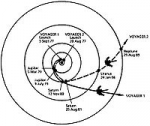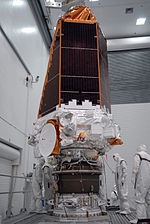Displaying items by tag: deep space
Voyager program
The Voyager program is a U.S program that launched two unmanned space missions, scientific probes Voyager 1 and Voyager 2. They were launched in 1977 to take advantage of a favorable planetary alignment of the late 1970s.
Although officially designated to study just Jupiter and Saturn, the probes were able to continue their mission into the outer solar system, and are as of December 2011 on course to exit the solar system. These probes were built at JPL and were funded by NASA. Voyager 1 is currently the farthest human-made object from Earth.
Both missions have gathered large amounts of data about the gas giants of the solar system, of which little was previously known. In addition, the spacecraft trajectories have been used to place limits on the existence of a hypothetical trans-Plutonian Planet X.
Kepler (mission & spacecraft)
The Kepler spacecraft is an American space observatory, the space-based portion of NASA's Kepler mission to discover Earth-like planets orbiting other stars. The spacecraft is named in honor of the 17th-century German astronomer Johannes Kepler. The spacecraft was launched on March 7, 2009, with a planned mission lifetime of at least 3.5 years.
The Kepler mission is "specifically designed to survey a portion of our region of theMilky Way galaxy to discover dozens of Earth-size planets in or near the habitable zone and determine how many of the billions of stars in our galaxy have such planets." Kepler's only instrument is a photometer that continuously monitors the brightness of over 145,000 main sequence stars in a fixed field of view. This data isanalyzed to detect periodic fluctuations that indicate the presence of extrasolar planets that are in the process of crossing the face of other stars.


